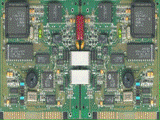Electrical and Computer Engineering, Department of
Document Type
Article
Date of this Version
2008
Abstract
In Wireless Multimedia Sensor Networks (WMSNs), low cost Complementary Metal Oxide Semiconductor (CMOS) camera sensors may only produce low resolution images due to hardware limitations. However, super-resolution images may be constructed from these low resolution images in a multiple sensor network, improving object pattern recognition success rates. There is a critical image recognition challenge in these reconstructed superresolution images for accuracy, complexity and limited energy resource in wireless sensor networks. Artificial Immune Systems (AIS), in particular those possessing algorithmic efficiency for image pattern differentiation, categorization and recognition, have potential advantages in low-cost automated monitoring and object detection applications. In this paper, we study the application of AIS for distributed and collaborative image pattern recognition in wireless multimedia sensor networks possessing energy efficient image communications and insitu image content processing. Our contributions are two fold. First, we propose an innovative approach involving dimension reduction to accelerate the AIS algorithm within an environment of low cost computing and efficient data transmission among the wireless sensor nodes. Second, a sleep control algorithm is proposed to reduce the image redundancies in order to achieve energy efficiency while guaranteeing the object recognition success rate in dynamic WMSN topology. Simulation results have demonstrated that the proposed approaches gain significant performance improvements in energy efficiency and in-network image content processing for WMSN. The algorithmic and simulation works are validated with the field data in collaborations between the University of Nebraska-Lincoln and Raytheon Company.



Comments
Published in MILCOM 2008. IEEE Military Communications Conference, 2008.
DOI: 10.1109/MILCOM.2008.4753651 Copyright 2008 IEEE. Used by permission.